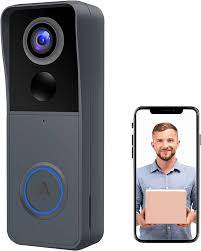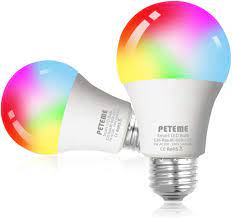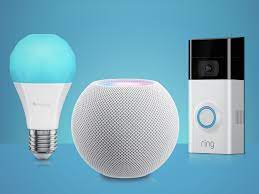 January 2024
January 2024
Today’s smart gadgets are automated in ways that were unthinkable until recently. They are made smarter with internet accessibility.
Here are a few gadgets that can make your home smarter. Most smart gadgets are individually priced at $100 to $400
Cameras
 Cameras for outside allow you to see who is at the front door, and speak with them via your smartphone even when not at home. Infrared night mode provides good visibility in the dark. Save and share clips in the cloud with an additional subscription service. Connect the camera to a smart speaker to receive audible alerts and two-way audio. When motion is detected the camera will start recording. Users can send notification to their smartphone when activation occurs with live footage viewed through a web browser. Voice command controls are available.
Cameras for outside allow you to see who is at the front door, and speak with them via your smartphone even when not at home. Infrared night mode provides good visibility in the dark. Save and share clips in the cloud with an additional subscription service. Connect the camera to a smart speaker to receive audible alerts and two-way audio. When motion is detected the camera will start recording. Users can send notification to their smartphone when activation occurs with live footage viewed through a web browser. Voice command controls are available.
Cameras can be activated to detect when a user leaves home and to record any entry during an absence. Indoors, cameras allow you to monitor activities when not at home. They are useful for keeping tabs on or speaking with pets and children. Indoor cameras for monitoring pets include wide-angle lens, digital zoom and two-way audio. An audio notification feature informs when barking or meowing is recognized.
One of the challenges in high-rise communities is that a few individuals may fail to accept the concept of community living and shared responsibility. They may force security doors open, fail to properly dispose of trash or leave anonymous notices on resident doors. Security cameras can’t be placed everywhere thus making it difficult to identify offenders. Smart cameras are low priced and can be temporarily located in problem areas. Cameras can operate wirelessly and are battery powered with local and on-line storage of recordings.
Smart Doors
 Smart doors can be locked and unlocked using a phone or smartwatch, or by entering a numeric code on a digital pad. No key is required. Deadbolt locks can even be locked and unlocked with your voice using a smart app such as Google Home. Just say “Google, lock the front door.” Send someone a temporary and custom code for limited access. An app shows when your lock has been accessed, and by whom. When changing the lock on your high-rise front door, inform building management and provide them with an emergency access key or code.
Smart doors can be locked and unlocked using a phone or smartwatch, or by entering a numeric code on a digital pad. No key is required. Deadbolt locks can even be locked and unlocked with your voice using a smart app such as Google Home. Just say “Google, lock the front door.” Send someone a temporary and custom code for limited access. An app shows when your lock has been accessed, and by whom. When changing the lock on your high-rise front door, inform building management and provide them with an emergency access key or code.
Lights
 LED light bulbs consume less power than incandescent and fluorescent bulbs, last longer and generate less heat. Smart bulbs can be managed through an app or smart speaker. Change their colour, dim or brighten a room, and schedule lights to turn on and off at pre-set times.
LED light bulbs consume less power than incandescent and fluorescent bulbs, last longer and generate less heat. Smart bulbs can be managed through an app or smart speaker. Change their colour, dim or brighten a room, and schedule lights to turn on and off at pre-set times.
Smart Temperature Control
 Smart thermostats can reduce your heating and cooling bill. Adjust temperature and comfort settings from an app, smart speaker, or by using the thermostat’s 3.5-inch touchscreen. Add room sensors for more precise control.
Smart thermostats can reduce your heating and cooling bill. Adjust temperature and comfort settings from an app, smart speaker, or by using the thermostat’s 3.5-inch touchscreen. Add room sensors for more precise control.
Smoke, Carbon Monoxide and Water Sensors
 Be informed when your home or its occupants are under threat from smoke, carbon monoxide or water. A voice warns when smoke or other danger is detected and tells you the location. Warnings can be sent to your smartphone. System algorithms know the difference between smoke from a fire and steam from a shower which minimize false warnings. Smart sensors will automatically test their batteries and sensors. An app can automatically silence an alarm from your smartphone.
Be informed when your home or its occupants are under threat from smoke, carbon monoxide or water. A voice warns when smoke or other danger is detected and tells you the location. Warnings can be sent to your smartphone. System algorithms know the difference between smoke from a fire and steam from a shower which minimize false warnings. Smart sensors will automatically test their batteries and sensors. An app can automatically silence an alarm from your smartphone.
Cleaning
 Have your own Rosie the Robot to keep your home clean. Systems are activated by voice control, pressing a button on the unit or an app on your phone. Wet mopping and dry sweeping pads are interchangeable. Systems can be directed to clean an entire floor, room or “around the kitchen table”.
Have your own Rosie the Robot to keep your home clean. Systems are activated by voice control, pressing a button on the unit or an app on your phone. Wet mopping and dry sweeping pads are interchangeable. Systems can be directed to clean an entire floor, room or “around the kitchen table”.
Robotic systems incorporate sensors that navigate a floor including around objects and under couches. Wireless systems will automatically dock and recharge when battery power runs low.







